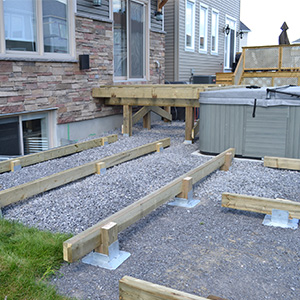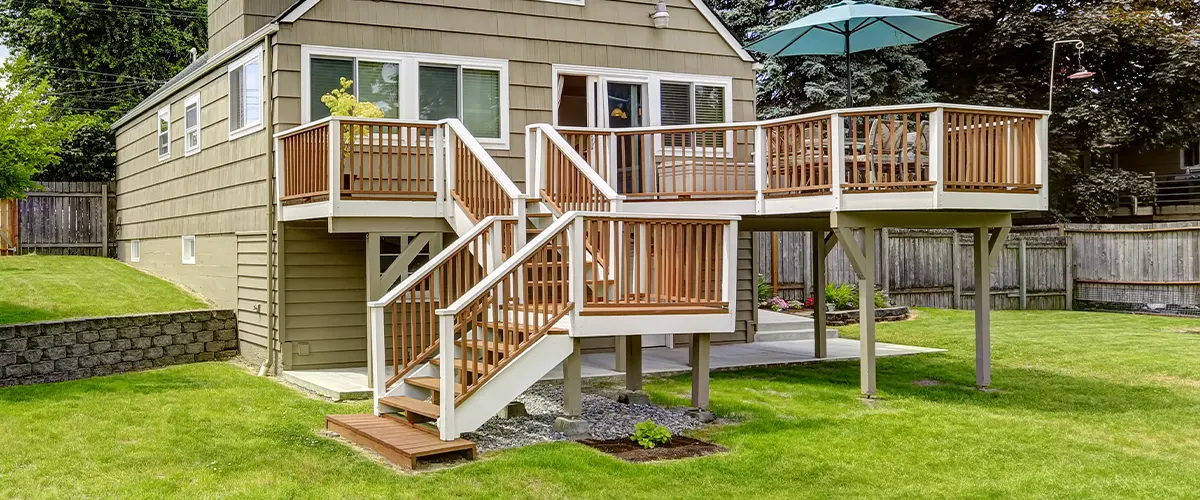Make Sure Security and Durability With Correctly Set Up Deck Footings
Deck footings may not be the most extravagant element of deck building and construction, yet they play an essential role in making certain security and durability. In this conversation, we will certainly check out the relevance of proper deck footings, variables to consider throughout installation, different kinds of footings available, detailed installation guide, and upkeep ideas for guaranteeing durable footings.

Importance of Correct Deck Footings
Why are appropriately mounted deck footings critical for the stability and long life of your deck? Deck grounds are the foundation on which the deck relaxes, moving the tons from the deck to the ground.
First of all, correctly installed deck footings disperse the weight of the deck evenly, protecting against any type of irregular settling or sinking. This is especially crucial in areas with unpredictable dirt, as it helps to alleviate the risk of the deck shifting or breaking down. Additionally, well-installed grounds guarantee that the deck continues to be level, protecting against any type of architectural damages that can happen when a deck comes to be uneven.
Secondly, appropriately set up footings provide a strong support for the deck, preventing excessive motion and guide. This aids to preserve the structural honesty of the deck, minimizing the threat of injuries or accidents. It also decreases the wear and tear on the deck, permitting it to endure the components and normal use for a longer period of time.
Factors to Consider for Deck Ground Setup
When mounting deck grounds, there are several crucial elements to think about for correct installment. Different dirt types have various load-bearing capacities, so it is essential to perform a dirt test to ensure the grounds can sustain the weight of the deck and its passengers. By taking right into account these elements, you can make sure the correct installation of deck grounds and delight in a stable and resilient deck.
Sorts Of Deck Grounds to Pick From
There are a number of different sorts of deck grounds available for you to select from. Each type has its own advantages and negative aspects, so it's essential to consider your details demands and the conditions of your deck before choosing.
One typical kind of deck ground is the concrete ground. This involves excavating holes in the ground and putting concrete into them to produce a solid foundation. Concrete footings are resilient and provide superb stability, making them suitable for decks in areas with tough soil conditions or high wind lots.
An additional alternative is the helical pier ground, which is composed of a steel shaft with helical plates that are screwed right into the ground. These footings fast to set up and can be utilized in various dirt kinds, including sandy or clay soils. They are additionally flexible, allowing for very easy leveling of the deck.
Sonotube grounds are an additional prominent selection. These grounds are developed by positioning a cardboard tube in an opening and loading it with concrete. Sonotube footings are reasonably very easy to mount and offer adequate stability for smaller sized decks or in locations with less requiring dirt problems.

When selecting the kind of deck ground, it's crucial to take into consideration aspects such as soil conditions, deck size and weight, local building ordinance, and personal preferences. By choosing the appropriate ground kind, you can guarantee the stability and longevity of your deck.
Step-by-Step Guide for Installing Deck Footings

Figure out the area: Begin by marking the specific position of each ground utilizing stakes and string (Deck Footings). Take into consideration any type of local building ordinance or policies regarding trouble distances
Dig the holes: Make use of an article opening digger or an auger to dig the holes for the footings. Normally, a depth of at least 36 inches is recommended for stability.
Degree the openings: Ensure that all-time lows of the openings are degree (Deck Footings). This can be attained by making use of a level or a straight board across the top of the holes
Add gravel: Area a layer of crushed rock at the end of each hole to enhance water drainage and stop the ground from sinking right into the dirt over time.
Insert the footing types: Put the footing develops into the holes, ensuring they are focused and level. link Use stakes to secure them in location.
Mix and put concrete: Comply with the instructions on the concrete mix bag to prepare the concrete. Put the concrete into the ground forms, loading them completely.
Smooth the surface: Use a trowel to smooth the surface of the concrete and get rid of any air pockets. Permit the concrete to treat according to the supplier's guidelines.
Upkeep Tips for Long-lasting Deck Grounds
Appropriate upkeep is crucial for ensuring the longevity and stability of deck footings. By regularly examining and maintaining your deck grounds, you can prevent damage and possible security dangers. One important aspect of upkeep is to regularly check for any kind of indicators of damage, such as splits or motion in the grounds. If you observe any kind of concerns, it is necessary to resolve them quickly to stay clear of further damage.
Routine cleaning is also crucial for keeping deck grounds. Dirt, particles, and plants can gather around the footings, which can bring about moisture buildup and decay. Cleansing the footings regularly, making use of a brush or a stress washer, can help protect against these problems and extend the life expectancy of your deck.
In addition to cleaning, it is necessary to keep the area around the grounds clear of any kind of blockages. Avoid piling products versus the footings or permitting plants to grow also close to them. These blockages can catch moisture and cause the footings to degrade over time.
Last but not least, routine resealing of the footings is recommended to shield them from moisture and other environmental elements. Using a water-proof sealant can aid protect against water damage and expand the life-span of the grounds.
Final Thought
In verdict, proper installation of deck grounds is vital for guaranteeing stability and longevity of your deck. Elements such as dirt kind, load ability, and local building ordinance require to be thought about when picking the best kind of deck grounds. Adhering to a step-by-step overview for setup and regular upkeep will certainly help to make certain the grounds stay sturdy and resilient.
In this discussion, we will explore the importance of appropriate deck grounds, aspects to consider during installation, different kinds of footings readily available, step-by-step installation guide, and upkeep suggestions for ensuring resilient footings. Deck grounds are the structure on which the deck relaxes, transferring the lots from the deck to the ground.One click for source typical kind of deck footing is link the concrete footing. Insert the ground kinds: Insert the ground forms into the holes, ensuring they are focused and level.In verdict, appropriate installation of deck grounds is vital for making sure security and longevity of your deck.
Comments on “Deck Footings Introduced: Comprehending the Key Elements of a Trusted Deck Structure”